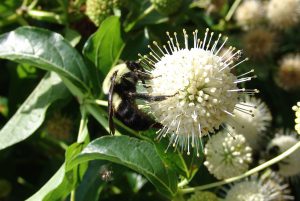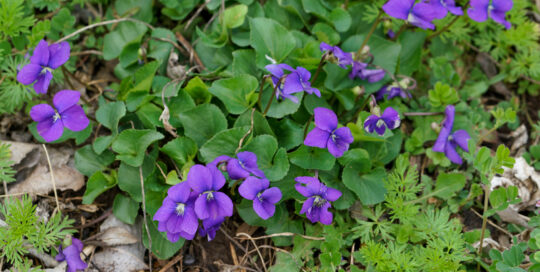How to utilize those soggy spots in your landscape
Views: 966

What to do with my swamp?
Over the last four months, my area of Oklahoma has received nearly 30 inches of rain. That’s pretty unprecedented and has caused a lot of flooding. For me, it’s especially problematic because I tend to plant drought-tolerant plants. Many are natives to dry areas such as western Texas and New Mexico. Needless to say, some of these plants, including the desert willow I planted last fall, are not doing well. Even my well-established rose of sharons (Hibiscus syriacus) are showing signs of distress.
But I have done one clever thing in my new yard: my sloping yard drains water toward my house, but instead of installing a French drain to funnel that water elsewhere, I decided to build a bed that could tolerate standing water. It’s not a true rain garden because it’s not engineered in any way. I just pulled the grass and weeds from the area, and I planted it with plants that could take advantage of soggy spots, yet could still survive a hot summer with hand-watering during drought.
The soil in this bed is a thin layer of composted leaves, built up over years, on top of thick, red clay. Dig down a foot, and the clay bleeds water into the hole. This was true until about August last year, at which point the clay turned into brick. It was hard planting things last fall because the clay was too hard to work with. I had to water my clay before trying to put plants into the ground.
Luckily, there are prairie natives that can survive and even thrive in such conditions. These plants adapted to wet springs and hot summers. Many of them taking advantage of low areas that collect water when it rains, then dry up later. Some go dormant in summer and come back in spring. Others are just so hardy that extremes in precipitation and soil don’t seem to bother them. I have killed a few things in this bed, including some pretty hardy coreopsis, so it is a work in progress with many lessons learned.
Plants that do well
Here are a few wildlife-friendly plants that have survived and even thrived in the soggy spots of clay in my garden:
• Buttonbush
(Cephalanthus occidentalis) – This native shrub is typically found in wetland areas, pond margins, floodplains, ditches, and other similarly wet places. However, they have proven to be hardy enough to withstand being planted in a parking lot in dry, well-drained soil. In Oklahoma, they are sometimes found beside cow ponds that typically retreat in July and August, leaving the plants far from the water’s edge. I thought summer had killed the first buttonbush I planted last year, but this spring it came back from the roots and has thrived in our monsoon. Buttonbush is a favorite of both honey and native bees, and its odd, round flowers are always covered in pollinators.
• Common Sneezeweed
(Helenium autumnale) – Blooming through summer and fall, sneezeweed does not acerbate allergies; it is so named because it used to be ground into a type of snuff. My little patch of soggy clay is perfect for this plant; it prefers moist clay soils. It is found naturally in wet meadows, on pond banks, and along streams. Also, it survived a hot, dry summer without stress in my flowerbed, so I think it will continue to do well. Sneezeweed is of special value to native bees, and I often found butterflies on it last summer.
• Rattlesnake Master
(Eryngium yuccifolium) – A member of the carrot family, rattlesnake master is native to prairies, rocky woods, and sandy glades and roadsides. In accordance with some reference sites, I first tried planting rattlesnake master in a sunny, sandy loam wildflower field. It eventually died. But Wildflower.org suggested using it in a water garden or bog, so I tried it in my soggy spot. It has thrived there so far. We’ll see if it makes it through the summer, but it looks so healthy right now I have high hopes, especially since many websites say it can tolerate dry soil, too. Rattlesnake master is attractive to pollinators.
• Swamp Milkweed
(Asclepias incarnata) – As the name implies, swamp milkweed is native to sunny areas in swamps and wetlands, but it may tolerate well-drained soils in garden situations. I have mine planted in dappled shade where the soil doesn’t dry out quite so badly. Unfortunately, the blooms last summer were small, so it might be happier with more sun. It did survive summer without wilting, possibly because these plants establish deep taproots. It looks very happy this spring, and I hope Monarch or Queen butterflies discover it as a host plant.
• Slender Mountain Mint
(Pycnanthemum tenuifolium) – Honestly, this plant is so easy to grow, I think it would survive almost anywhere except, perhaps, full shade. It did well in a sandy, dry, rock garden, and it is doing well in my clay bog. It bloomed happily all summer and fall. Also, it has a taproot and spreads via rhizome to form dense clumps that are visited by all types of pollinators when in bloom.
• Common Boneset
(Eupatorium perfoliatum) – I have this planted at the back of my bed because it can grow quite tall, up to six feet in the right conditions. Common boneset benefits pollinators and birds.
The plants on this list are native throughout the eastern half of the country and parts of eastern Canada. Though, a few, like buttonbush and sneezeweed, grow almost everywhere in the U.S.
I have other plants that are doing well in this bed, including mint, day lilies, bearded iris, St. John’s wort, and crinum lilies. Hopefully, if you have your own soggy spots, this list will give you some ideas for plants that can take advantage of such conditions.
Meet Leslie Miller
Leslie Ann Miller shares 3.5 acres in rural Oklahoma with birds, butterflies and wide variety of animals. She is currently transforming her yard with plantings…
Leslie's Recent Posts

Early spring is time to plant native spring ephemerals






